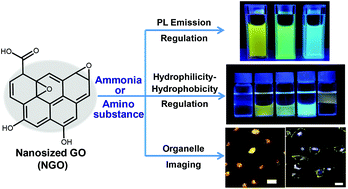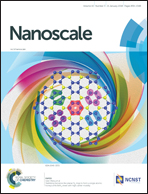A versatile platform for the highly efficient preparation of graphene quantum dots: photoluminescence emission and hydrophilicity–hydrophobicity regulation and organelle imaging†
Abstract
In this work, a versatile platform for the highly efficient preparation of graphene quantum dots (GQDs) with diverse properties was developed. First of all, an excess amount of oxidants and an additional high temperature step of the Hummers’ method for the synthesis of graphene oxide (GO) was applied to obtain nanosized graphene oxide (NGO). Then, high quality GQDs (quantum yields up to 18.2%) with different photoluminescence emission wavelengths, adjustable hydrophilicity–hydrophobicity, and selective cell organelle imaging capacity can be facilely achieved through a one-pot hydrothermal reaction between the NGO and ammonia, fatty primary amines, or amino-substituted organelle targetable compounds, respectively. The superior features of the as-developed method are extremely high conversion ratio (ca. 60 wt% from graphite to the functional GQDs) and great expandability. Such a high conversion ratio is deemed to be due to effectively decreasing aggregation of the NGO (in comparison with GO) during the post-treatment process. This work provides a robust strategy for the highly efficient preparation of GQDs with diverse properties and functions, and is believed to be beneficial for boosting their applications in the future.



 Please wait while we load your content...
Please wait while we load your content...